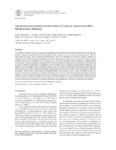Use este identificador para citar ou linkar para este item:
http://www.alice.cnptia.embrapa.br/alice/handle/doc/488374| Título: | Agrobacterium-mediated transformation of sorghum: factors that affect transformation efficiency. |
| Autoria: | CARVALHO, C. H. S.  ZEHR, U. B.   GUNARATNA, N.   ANDERSON, J.   KONONOWICZ, H. H.   HODGES, T. K.   AXTELL, J. D.   |
| Afiliação: | CARLOS HENRIQUE S DE CARVALHO, Embrapa Milho e Sorgo; Usha B. Zehr, Purdue University; Nilupa Gunaratna, Purdue University; Joseph Anderson, Purdue University; Halina H. Kononowicz, Purdue University; Thomas K. Hodges, Purdue University; John D. Axtell, Purdue University. |
| Ano de publicação: | 2004 |
| Referência: | Genetics and Molecular Biology, Ribeirão Preto, v. 27, n. 2, p. 259-269, 2004. |
| Conteúdo: | The results presented in this work support the hypothesis that Agrobacterium-mediated transformation of sorghum is feasible, analogous to what has been demonstrated for other cereals such as rice, maize, barley and wheat. The four factors that we found most influenced transformation were: the sensitivity of immature sorghum embryos to Agrobacterium infection, the growth conditions of the donor plant, type of explant and co-cultivation medium. A major problem during the development of our protocol was a necrotic response which developed in explants after co-cultivation. Immature sorghum embryos proved to be very sensitive to Agrobacterium infection and we found that the level of embryo death after co-cultivation was the limiting step in improving transformation efficiency. The addition of coconut water to the co-cultivation medium, the use of vigorous and actively growing immature embryos and the removal of excess bacteria significantly improved the survival rate of sorghum embryos and was critical for successful transformation. Hygromycin phosphotransferase (hpt) proved to be a good selectable marker for sorghum. We also found that β-glucuronidase (GUS) activity was low in most of the transgenic plant tissues tested, although it was very high in immature inflorescences. Although promising, the overall transformation efficiency of the protocol is still low and further optimization will require particular attention to be given to the number of Agrobacterium in the inoculum and the selection of sorghum genotypes and explants less sensitive to Agrobacterium infection. |
| Thesagro: | Sorgo |
| Tipo do material: | Artigo de periódico |
| Acesso: | openAccess |
| Aparece nas coleções: | Artigo em periódico indexado (CNPMS)  |
Arquivos associados a este item:
| Arquivo | Descrição | Tamanho | Formato | |
|---|---|---|---|---|
| Agrobacteriummediated.pdf | 611,41 kB | Adobe PDF |  Visualizar/Abrir |









